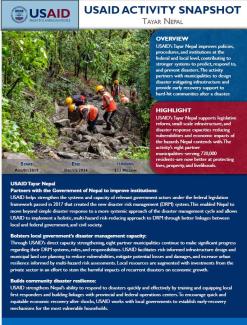START: AUG/01/2019 | END: DEC/15/2024 | FUNDING: $33 MILLION
OVERVIEW
USAID’s Tayar Nepal improves policies, procedures, and institutions at the federal and local level, contributing to stronger systems to predict, respond to, and prevent disasters. The activity partners with municipalities to design disaster mitigating infrastructure and provide early recovery support to hard-hit communities after a disaster.
HIGHLIGHT
USAID’s Tayar Nepal supports legislative reform, small-scale infrastructure, and disaster response capacities reducing vulnerabilities and economic impacts of the hazards Nepal contends with. The activity’s eight partner municipalities–serving 720,000 residents–are now better at protecting lives, property, and livelihoods.
USAID Tayar Nepal Partners with the Government of Nepal to improve institutions:
USAID helps strengthen the systems and capacity of relevant government actors under the federal legislation framework passed in 2017 that created the new disaster risk management (DRM) system. This enabled Nepal to move beyond simple disaster response to a more systemic approach of the disaster management cycle and allows USAID to implement a holistic, multi-hazard risk-reducing approach to DRM through better linkages between local and federal government, and civil society.
Bolsters local government’s disaster management capacity:
Through USAID’s direct capacity strengthening, eight partner municipalities continue to make significant progress regarding their DRM systems, roles, and responsibilities. USAID facilitates risk-informed infrastructure design and municipal land use planning to reduce vulnerabilities, mitigate potential losses and damages, and increase urban resilience informed by multi-hazard risk assessments. Local resources are augmented with investments from the private sector in an effort to stem the harmful impacts of recurrent disasters on economic growth.
Builds community disaster resilience:
USAID strengthens Nepal’s ability to respond to disasters quickly and effectively by training and equipping local first responders and building linkages with provincial and federal operations centers. To encourage quick and equitable economic recovery after shocks, USAID works with local governments to establish early-recovery mechanisms for the most vulnerable households.


